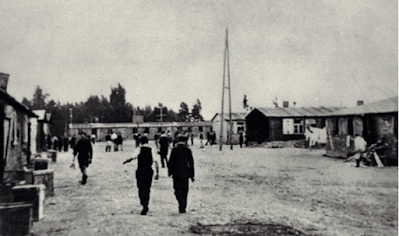Located in Matzicken are the home, and one-time estate,
of the Sudermann family where Herman Sudermann (1827 – 1928) was born. Once considered one of
His novels did much to popularize the land and the
people. These days he is a forgotten
author from a forgotten area. Probably
the most important of his works is Lithuanian
Stories written in 1917. Now that
I’ve actually experienced this countryside, if not the life of bygone days, I might try to find that book to read so I can capture a sense of that lifestyle, those
years about which my parents would reminisce.
The house of the former Sudermann estate is easy to miss. Only after our second drive by did we notice the small plaque stuck on the front. The estate is long gone. It wasn’t clear if the building was a museum, or a private home, or if it was even open to the public. No idea what might be on display there so we didn’t try to go inside. The place looked forlorn.
More interesting is what we found down the road from
the Sudermann house - an actual prisoner of war camp. The grounds are fenced off and the gate locked
so we couldn’t go in or look in the buildings. My mother recalled this camp from the early 1940’s.
 |
| Ruth Redetzki |
Ruth, youngest of the Redetzki girls, belonged to the
BDM – Bund Deutscher Mädchen, a Hitler youth group for young girls. We have this little photo of Ruth in her
uniform, about age 13. It shows a young
girl dressed in a white blouse, black bandana held with a leather bolo, hair in
two long, straight, pigtails. The family were supposed to purchase one of the
regulation outfits that would have ensured the highest conformity with uniform
standards. The Redetzki family didn’t
have the money to buy a new uniform and told her and the group she had to
make do with the clothes she already had. My
mother remembers the old blouse Ruth had to use for the photo. Money, or lack of it, overrode politics and the
need to conform to the prevailing group think.
Standards were likely to be less strict among poor, rural areas, as they
often are.
My mother fought repeated exhortations to join any political
youth groups. She proved evasive and
avoided commitment. I don’t think it was
opposition to the politics – more dislike of the group. And my mother was at an age where she
was too old for a youth group. Sister
Herta was also apolitical and plain not interested. Fortunately for them their
location and rural life spared them the political pressures faced
by city populations.
Ruth’s duties included going to the camp, for some
purpose, which turned out to be quite lucrative for her and the family. She received chocolates and gifts that soldiers
got in Red Cross packages. The rations for the Germans were already meager; the
country was fighting a war on two fronts. Any food items from these packages were a great treat for her family. My mother says the soldiers did it out of
generosity, feeling sorry for this little kid (she was a bit scrawny and cross
eyed). Ruth herself says she doesn’t
remember anything from those war years. I wonder if they got the goods
from the packages another way; maybe they were opened and the contents
ransacked by the Germans before the soldiers ever even got them. But that would have been kept by the officers
and not given away to locals.

Again I read through the prisoner’s stories searching for
a reference to local children who came to the camp. Were the stories I was told true accounts,
did these little girls in their neat uniforms make any impression on these
prisoners? I wanted verification of the
existence of the Redetzkis, that someone knew of them. In a way it is a validation of life if someone
remembers, maybe only in a passing reference.
Ah, but to exist on the internet is to live for eternity, is it not?
We walk along the camp fence down the lane to a small
cemetery. Was this a village cemetery, I wonder? Gravemarkers looked different so we walk in to read the inscriptions. These are graves of Americans and British who
died while interned at the camp. Set at
the back of the cemetery are more gravestones with Lithuanian names. No Lithuanians were housed with the Allied pilots;
the dates clearly show these people died after the war. Guess what - they died at the hands of their
liberators, the Russians. Once Lithuanians
were freed from their wretched Nazi oppressors, they then could experience
death at the hands of the Russians as they were being unenslaved! The liberators moved in and made use of the
camp to house Lithuanian prisoners; no sense wasting prison space or shipping
them off to furthest Russia. The pilots were
evacuated by the Germans in advance of the Russian invasion.
History relates a burden on the poor Lithuanians. First, shared borders with Germany, reminding
me of the old adage about sleeping next to an elephant. (No wait, if





No comments:
Post a Comment